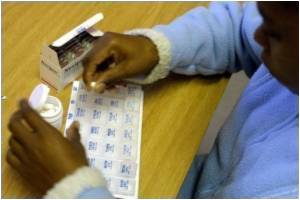In a rural part of southwestern Uganda, population-wide levels of HIV virus fell noticeably between 2011 and May 2012. The site of two community health campaigns was led by doctors.

Mounting evidence is showing that universal testing and early treatment for HIV can help keep people healthier longer and can reduce the spread of HIV within communities.
In a talk to be presented on Tuesday, July 24, 2012 at the XIX International AIDS Conference in Washington, D.C., members of the UCSF research team will describe early results of their campaign in one resource-limited setting in sub-Saharan Africa, where 60 percent of the world's HIV-infected people reside.
Their effort involved two large community health campaigns in May 2011 and May 2012, in which every resident in a southwestern Ugandan district called Kakyerere Parish (population 6,300) was offered free counseling, testing for HIV and other diseases, and linkage to care. Between the two campaigns, there was a substantial drop in the amount of HIV virus measured in the community.
In 2011, 37 percent of HIV-positive persons had undetectable levels of virus, and by 2012 that number had risen to 55 percent. By contrast, only an estimated 20-30 percent of the people in the United States who are infected have undetectable levels of HIV-in part because 1 in 5 Americans living with HIV do not know they are infected.
"Viral loads in the population can be a readout of how we are doing with HIV care across the whole district," said Vivek Jain, MD, MAS, assistant professor of medicine in the UCSF Division of HIV/AIDS at SFGH. "More people in Uganda are accessing therapy, and the therapy they are accessing is achieving success."
Advertisement
In the 2012 study, 4,872 total people (2,271 adults) were tested for HIV over a one-week period, and 210 community adults tested positive for HIV. Those who tested positive were given a separate test to determine the amount of virus in their bloodstream-a quantity known as "viral load."
The scientists employed a new method for measuring viral load on-site by taking four drops of blood through a simple finger prick, avoiding the need for standard, more time consuming blood draw procedures that use needles.
Advertisement
"Every way you look at it, there is less virus in this community," said Diane Havlir, MD chief of the UCSF Division of HIV/AIDS at SFGH and co-director of the SEARCH Collaboration.
There were several possible reasons for the drop in virus, said Jain. To begin with, the community health campaign of 2011 helped identify more people who were infected (including many people who previously did not know they were HIV-positive), and helped link them to medical care. Second, the government of Uganda recently changed the guidelines for offering treatment to allow access to antiretroviral drugs earlier in the course of the HIV disease process, at a higher T cell count threshold.
Finally, people in the community who did not qualify for drugs under the Ugandan government guidelines were nevertheless given access to antiretroviral therapy through a research study also being conducted by the SEARCH group in the district: this study offers therapy to persons at any T cell count, creating an option for residents to access therapy even if their T cell counts are still high.
To build on these encouraging pilot results, said Jain, a large clinical study is needed to rigorously study whether the reduction in virus levels in the population is a direct result of the community health campaign and the expanded access to HIV medicines in the district.
The late-breaker talk, "Changes in population-level HIV RNA distribution one year after implementation of key components of an HIV ''test and treat'' strategy in rural Uganda" by V. Jain, D. Kwarisiima, T. Liegler, T. Clark, G. Chamie, J. Kabami, D. Black, G. Amanyire, D. Byonanebye, E. Geng, H. Thirumurthy, M. Petersen, E. Charlebois, M. Kamya, D. Havlir, and the SEARCH Collaboration will be presented at the XIX International AIDS Conference in Washington, D.C. at 11:00 a.m. ET on Tuesday, July 24, 2012 in Mini Room 9.
In addition to UCSF and SFGH, authors of this study are associated with the Makerere University-University of California, San Francisco (MU-UCSF) Research Collaboration in Kampala, Uganda, the Mulago-Mbarara Teaching Hospitals' Joint AIDS Program (MJAP) in Kampala, Uganda, the University of California, Berkeley and the University of North Carolina, Chapel Hill. The work was funded by the National Institute of Allergy and Infectious Diseases, one of the National Institutes of Health.
UCSF is a leading university dedicated to promoting health worldwide through advanced biomedical research, graduate-level education in the life sciences and health professions, and excellence in patient care.
Source-Newswise















